The essence of a great science fiction or fantasy novel is the world. There, I said it. Feel free to disagree. But I haven’t fallen in love with a novel without first falling deep into the author’s imaginary world. So naturally it was the most extreme worlds that became my favorites. And in the hands of the best authors those unique worlds produced not only memorable places and stories, but fertile ground for things like social and political commentary as well. There is something to be said for taking things to their limits. In each of these novels the author has taken ideas about our humdrum world and pushed them to the extreme (as if I hadn’t already overused that word). In doing this, in seeing these exaggerated versions of our world, we are allowed glimpses of possible futures or of alternate versions of the present or even the past.
The Drowned World by J.G. Ballard
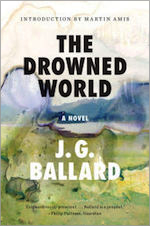 To grasp the significance of J.G. Ballard’s novel it’s important to remember that it was written in 1962 because it sounds like a novel that was written in the last few years. In fact, more than one book has been written in the last few years with a similar premise. The Drowned World was the first book I read in what I’ll call the “scientific expedition into an unknown world” genre. A kind of global warming has devastated the world. The polar ice caps are melted, flooding the northern hemisphere, transforming the land into something that resembles the Triassic period (now that’s extreme). But what’s truly great about The Drowned World is the way in which this transformation shapes and affects the characters. Our protagonist literally finds himself regressing into an earlier state, feeling more primitive and impulsive, devolved like his world. It’s a perfect of example of the interplay of character and environment and a keen commentary on the fragility of our society.
To grasp the significance of J.G. Ballard’s novel it’s important to remember that it was written in 1962 because it sounds like a novel that was written in the last few years. In fact, more than one book has been written in the last few years with a similar premise. The Drowned World was the first book I read in what I’ll call the “scientific expedition into an unknown world” genre. A kind of global warming has devastated the world. The polar ice caps are melted, flooding the northern hemisphere, transforming the land into something that resembles the Triassic period (now that’s extreme). But what’s truly great about The Drowned World is the way in which this transformation shapes and affects the characters. Our protagonist literally finds himself regressing into an earlier state, feeling more primitive and impulsive, devolved like his world. It’s a perfect of example of the interplay of character and environment and a keen commentary on the fragility of our society.
The Windup Girl by Paolo Bacigalupi
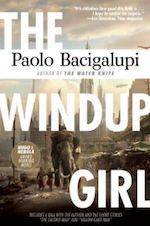 Here we encounter another world wrecked by flooding and eco-disasters, a world in which biological plagues wreak havoc on the population and strange, genetic experiments run wild (a population of feral Cheshire Cats). We are in the drowned world of 23rd century Thailand, a place that is powered (literally) by springs (check the title of the book). Food sources are controlled by vast global conglomerates (this one is just a fact of the modern world) and the last remaining seed bank is a treasure our protagonist will do anything to acquire. The Windup Girl might just be the future of agriculture or our present.
Here we encounter another world wrecked by flooding and eco-disasters, a world in which biological plagues wreak havoc on the population and strange, genetic experiments run wild (a population of feral Cheshire Cats). We are in the drowned world of 23rd century Thailand, a place that is powered (literally) by springs (check the title of the book). Food sources are controlled by vast global conglomerates (this one is just a fact of the modern world) and the last remaining seed bank is a treasure our protagonist will do anything to acquire. The Windup Girl might just be the future of agriculture or our present.
The Left Hand of Darkness by Ursula K. Le Guin
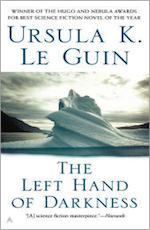 There is a point in the novel where the narrator, Genly Ai, wonders whether the peculiar nature of the people of Gethen—also known as Winter, the perpetually cold and snowy planet in Ursula K. Le Guin’s The Left Hand of Darkness—are a product of the extreme environment or some sort of genetic experiment long ago abandoned. We never discover the answer. Rather, Le Guin’s novel is a meditation on the nature of the Gethenites’ sexual identity. See, the people of Winter have no fixed sex. They shift from male to female in a cycle and choose partners to suit their current sex. Our narrator is an envoy, a man from another world trying to make first contact with Gethen. He is ultimately thrown out by one faction, embraced by another, betrayed, befriended, and saved. The novel concludes with one of the more memorable segments in science fiction, a month’s long journey across a glacier that leaves Genly (male) alone with Estraven (alternately male and female). The two are trapped, isolated as they move across the ice. In this private world we confront the notion of what it is to be a man or a woman and how we define our relationship between the two.
There is a point in the novel where the narrator, Genly Ai, wonders whether the peculiar nature of the people of Gethen—also known as Winter, the perpetually cold and snowy planet in Ursula K. Le Guin’s The Left Hand of Darkness—are a product of the extreme environment or some sort of genetic experiment long ago abandoned. We never discover the answer. Rather, Le Guin’s novel is a meditation on the nature of the Gethenites’ sexual identity. See, the people of Winter have no fixed sex. They shift from male to female in a cycle and choose partners to suit their current sex. Our narrator is an envoy, a man from another world trying to make first contact with Gethen. He is ultimately thrown out by one faction, embraced by another, betrayed, befriended, and saved. The novel concludes with one of the more memorable segments in science fiction, a month’s long journey across a glacier that leaves Genly (male) alone with Estraven (alternately male and female). The two are trapped, isolated as they move across the ice. In this private world we confront the notion of what it is to be a man or a woman and how we define our relationship between the two.
Dune by Frank Herbert
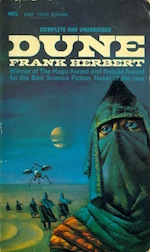 Arrakis, also called Dune, is a planet entirely devoid of surface water, a desert from top to bottom. And everyone who lives there—the native population, the fremen—is entirely focused on conservation and desert survival. The desert of Arrakis is merciless, but it’s also the only place in the universe where the spice, mélange, exists. Born of sandworms, the spice is a kind of catchall mystical, pseudo-scientific, quasi-religious super drug. Control of the spice equals control of the empire. And the spice is born out of this extreme environment, as are its spice-consuming, blue-within-blue-eyed population, the fremen. These folk are the true children of the desert. Their stillsuits turn every man or woman into a walking ecosystem, a self-sufficient, recycling machine in stylish brown leather. There are a hundred different reasons to praise Dune, but it was the severity of Herbert’s depiction of desert life that most struck me when I first read it.
Arrakis, also called Dune, is a planet entirely devoid of surface water, a desert from top to bottom. And everyone who lives there—the native population, the fremen—is entirely focused on conservation and desert survival. The desert of Arrakis is merciless, but it’s also the only place in the universe where the spice, mélange, exists. Born of sandworms, the spice is a kind of catchall mystical, pseudo-scientific, quasi-religious super drug. Control of the spice equals control of the empire. And the spice is born out of this extreme environment, as are its spice-consuming, blue-within-blue-eyed population, the fremen. These folk are the true children of the desert. Their stillsuits turn every man or woman into a walking ecosystem, a self-sufficient, recycling machine in stylish brown leather. There are a hundred different reasons to praise Dune, but it was the severity of Herbert’s depiction of desert life that most struck me when I first read it.
Solaris by Stanislaw Lem
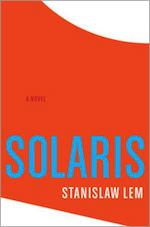 Okay, I saved this one for last because Stanislaw Lem’s Solaris gets the prize for most extreme world. Solaris, the eponymous planet, contains only one living organism. The planet wasn’t populated by a billion life forms that rose out of the ocean, rather the planet-sized ocean became a single life form. As the novel opens we learn that scientist have already spent decades studying the ocean. Volumes have been written about it. Generations have studied Solaris, but the ocean remains a mystery. The people of earth are unable to communicate with Solaris and it’s not for want of trying. Even the planet wants to communicate with humanity. It creates grand structures and humanoid figures, using mimicry to attempt communication. It doesn’t work. Contact is never achieved. Solaris is about the limitations of our species. It’s about trying to understand something that is completely different from you. It’s a contemplation of what is alien and thus human as well.
Okay, I saved this one for last because Stanislaw Lem’s Solaris gets the prize for most extreme world. Solaris, the eponymous planet, contains only one living organism. The planet wasn’t populated by a billion life forms that rose out of the ocean, rather the planet-sized ocean became a single life form. As the novel opens we learn that scientist have already spent decades studying the ocean. Volumes have been written about it. Generations have studied Solaris, but the ocean remains a mystery. The people of earth are unable to communicate with Solaris and it’s not for want of trying. Even the planet wants to communicate with humanity. It creates grand structures and humanoid figures, using mimicry to attempt communication. It doesn’t work. Contact is never achieved. Solaris is about the limitations of our species. It’s about trying to understand something that is completely different from you. It’s a contemplation of what is alien and thus human as well.
 Michael Johnston has always been an avid reader of science fiction and fantasy. He studied architecture and ancient history at Lehigh University and earned a master’s degree in architecture from Columbia University. Michael worked as an architect in New York City before switching to writing full time. He is the co-author of the YA Heart of Dread trilogy with his wife, Melissa de la Cruz. His new book, Soleri, is now available from Tor. He lives in Los Angeles with his wife and daughter. You can find him online at his website and on Twitter @MJohnstonAuthor.
Michael Johnston has always been an avid reader of science fiction and fantasy. He studied architecture and ancient history at Lehigh University and earned a master’s degree in architecture from Columbia University. Michael worked as an architect in New York City before switching to writing full time. He is the co-author of the YA Heart of Dread trilogy with his wife, Melissa de la Cruz. His new book, Soleri, is now available from Tor. He lives in Los Angeles with his wife and daughter. You can find him online at his website and on Twitter @MJohnstonAuthor.










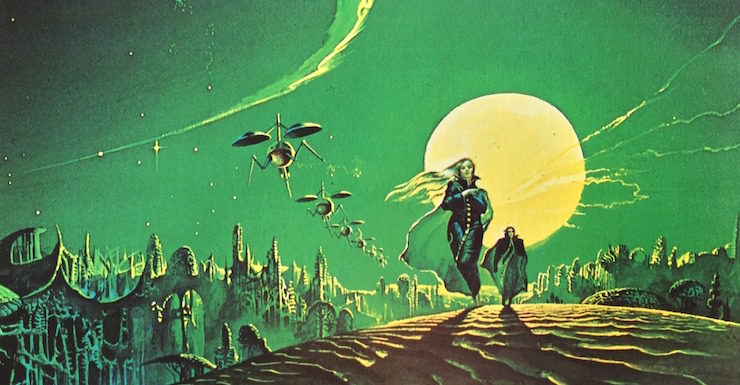
Came for Hal Clement’s Mesklin and the setting of Christopher Priest’s Inverted World, was somewhat satisfied with what was presented instead.
How about Harry Harrison’s Deathworld?
@1 SchuylerH: Clement loved extreme worlds. I came here for Mesklin, too, but there’s also Earth in Nitrogen Fix and the planets in Ocean On Top and Cycle of Fire.
Robert Forward, Dragon’s Egg and Rocheworld
Larry Niven, pretty much every planet in Known Space… plus the Smoke Ring (for certain values of “planet”).
I had some lovely worldbuilding conversations with Hal Clement yeara ago at Stellarcon. I wrote romance at the time, and science fiction romance was just starting. We joked about putting a bordello on Mesklin for the flat caterpillars so his books could have some sex in them, and, between us, we created a totally ridiculous Looooooove planet where red hearts prevailed. He was a charming gentleman.
Any world that gets constantly wrecked by a magical hurricane, causing organisms to evolve to survive, gets my vote. See Sanderson, Brandon.
I’d say at least half, if not more, of Brandon’s (Sanderson) Cosmere planets are pretty extreme. Roshar (regular storms that have shaped the whole flora and fauna to survive), Taldain (half of the planet has only sunlight (no night) and sun while the other half is constantly dark), pre-Harmony Scadrial (ash, ash everywhere!), … And all these planets shape the life on them to match these environments.
Under the dune entry, the natives are called fremen.
You can’t get much more extreme than the planet in A Deepness In The Sky, cycling from earthlike to snowball and back as the star it orbits switches on and off. When the star turns off, life on the planet goes dormant or hibernates as the atmosphere freezes. When the star turns back on, intense heat and storms reshape the landscape before things settle back down.
@8 – Fixed, thank you!
Brian Aldiss’ Helliconia trilogy is set on a world with centuries-long seasons, where winter and summer are so intense that evolution happens over a span of centuries rather than millennia.
I also came in expecting Hal Clement or Robert Forward to make the cut… But their stories (especially Forward’s) tend to be more *about* the world and not so much on how it affects the characters in them.
How about Ballybran in the Crystal Singer books by Anne McCaffrey? Violent electrical storms and if you go down to the planets surface, you end up with a genetic mutation making it difficult to ever leave the planet again.
How about Pluto, as portrayed in Heinlein’s Have Spacesuit, Will Travel? Poor Kip has to have advanced alien medical technology rebuild his body after only about fifteen minutes outside.
Oh, and Harry Stubbs (Hal Clement) was a master at worldbuilding. My dad introduced me to him at one of those panels, and whenever I attended a convention where he was present, I made sure and went to his panels.
Spatterjay is pretty rough.
@6 & @7 Yep, Brandon Sanderson has this category all locked up, for sure. But of course we knew that. Can’t expect a shout-out every time an article infringes on the territory.
For mindboggling world building, nothing beats John Varley’s Gaia series: Titan, Wizard, and Demon.
One more vote for Mesklin. I keep returning to “Mission of Gravity” because I fell in love with the world. I was surprised it didn’t make the list (but then again, on the plus side, I get to know of some new worlds I might not have encountered otherwise. So thanks!)
Hothouse by Brian Aldiss is Earth taken to an extreme (and H G Wells does the same, albeit in less detail, in The Time Machine). These were among my earliest introductions to SF and left a deep impression.
Then there’s Cue Ball, the antimatter world in a Larry Niven short story. Actually, many of Niven’s Known Space worlds are extreme – We Made It, Plateau, Jinx – but the most extreme ones like Cue Ball and the neutron star don’t have life. (Pluto does have the helium creatures so maybe I should nominate that!).
And if we don’t insist on strictly close-to-spherical worlds and allow stuff like the Ringworld or the Discworld, then Iain Banks’ real estate covers a pretty versatile range.
~lakesidey
Thanks for this book
@18. Gwyndyn T. Alexander
You beat me to it. I love John Varley’s trilogy and I don’t think they get the love they deserve. And for anyone that hasn’t read him, his world building is so f****d up, and I mean that in the best possible way
The world of N.K. Jemisin’s Fifth Season is pretty extreme …
As is Alan Dean Foster’s Midworld.
@18, @21 but in the Gaea series (IIRC, it’s been a while) the world, while strange, isn’t really an extreme environment, at least from the point of view of humans. There is no need for even baseline humans to have any protection from the world right? The strangeness came from the alien life and mysterious mechanisms…
@9 kaiphranos
This would be on my list too. I just happen to be rereading it. Vernor Vinge doesn’t write many books but maybe that’s a good thing seeing the quality of his work. Larry Niven has written plenty that stokes my sense of wonder- the Ringworld and Shipstar series, The Smoke Ring and The Integral Trees…they would all be on my personal list.
This is a good place to reflect on why we all love Sci Fi!
@23. vinsentient. Without giving too much away for those who haven’t read the Gaea trilogy, the world SEEMED to be safe not extreme for humans but it change people in insidious ways that they themselves didn’t realize at first.
Though I don’t care for the series, Peter V. Brett’s The Demon Cycle series has a pretty extreme world. Demons rise up from the ground at night, forcing people to hide behind wards and effectively eliminating the concept of overnight travel.
“Red Claw” by Philip Palmer
OK, worlds missed, off the top of my head:
1) Harry Harrison’s Deathworld 1
2) Poul Anderson’s Satan’s World
3) OK, short story, but Richard McKenna’s Hunter, Come Home – another Deathworld lookalike
4) Poul Anderson’s Call Me Joe, another short story – about Jupiter, and which may or may not have inspired Avatar.
@25 mammam OK I buy that explanation.
Not a setting for an entire book, but one world that always intrigued me was Trenco, the source of that insidious drug, thionite!
My favorite strange planet would be Briand, from John Barnes’ Earth Made of Glass. It’s a harsh and beautiful book about a harsh and beautiful planet.
I got triggered by the concept of Solaris. I would like to read that novel. But after some research it seems there are several English translations, one better than the other. After reading some articles, I found out that the translation of Bill Johnston would be the best as it is translated into English straight from the original Polish version.
But this version is hard to find. I already checked several online stores. I want to read the English epub version. Does anybody know where to buy this one?
Maybe a little off-topic, but as in the Solaris concept, where communication between very distinct alien races is the topic, I definitely recommend the Ender’s Saga of Orson Scott Card, especially the sequels of Ender’s Game: Speaker of the Dead, Xenocide and Children of the Mind. Very good philosophical and psychological stuff.
To come back to the topic. In the Deathstalker series from Simon Green, there is a planet, I believe it’s Mistworld, with a very short season cycle, something like going through the 4 seasons in 1 week. Quite extreme for me too.
@29. vensentiet. Lensman! We’ll go get dosed together!
Yeah, I know it gets less love these days for its hyper-masculine colonial fantasies, but I immediately thought of Deathworld.
Maybe too on the nose?
Hyper masculine colonial fantasies? As I recall the whole point of the book is that the Pyrrhans aggression is the source of their problems.
I would recommend Elantis by Brandon Sanderson.
I have to agree that a unique and interesting world can really capture my imagination and get me into a book. Niven’s Ringworld and Smoke Ring books, Forward’s Dragon’s Egg, Ellison’s Medea and many others.
I came down to Comments to add Mission of Gravity as well, but now I’ll go way back and add the thionite planet from Doc Smith’s Lensman series. A normal planet except that its atmosphere is a material with near zero heat of vaporization and a boiling point between the daytime temp and night time temp. The result is alternating direction gales every morning and evening that put earth tornados to shame.
Sorry if it’s been said, but what about Adrian Tchaikovsky’s Children of Time and its planet of GIGANTIC AND SUPERSMART SPIDERS AND ANTS!
How about Jack L. Chalker’s Well World? Over 1500 distinct ecological regions, each kept separate and with its own dominate life form…
Does no one read Alastair Reynolds??? He is definitely one of the best at creating ‘extreme worlds’.
The Lazarus Effect by Frank Herbert.
Sheri S. Tepper’s Grass
A Door into Ocean by Joan Slonczewski
Nicola Griffith’s Ammonite
Zelazny’s Amber, of which all other worlds are merely shadows…
I certainly can’t fault “Hal Clements” world of Mesklin! But for more recent terrific world-building, I have to go with Julie Czerneda’s “prequel” to her Trade Pact Universe – her “Clan Chronicles”. Yeah, the Om’ray, Tikitik, and Oud are fantastic (and believable!) peoples, but the planet, Cersi, is a wonderful, exotic (and yet, familiar) world. (I’d have picked, too, the Atevi World of CJ Cheryh’s “Foreigner” novels, but while we get a good description of the world, it almost seems secondary to the people populating it. (I still LOVE that series!))
The Left Hand of Darkness is a great book, but IMO a stretch for this category; we see the worst that Gethen can offer because the leads escape over the ice cap. There are cute touches (the table utensil for cracking the ice off one’s drink), but the binding between the sex-changing people and the cold environment seems weak.
Everybody’s bringing up Clement, but nobody has raised his most revolutionary novel. Iceworld, in which he boots Campbell’s anthropocentrism by showing that extreme is a point of view rather than an absolute; the title refers to Earth as seen by a species accustomed to such heat that even Mercury (when it was still thought to be sun-locked) isn’t warm enough until a small crater is turned into a reflector oven. And Laj Drai is a worthwhile character, not just a device for touring the world; he’s been drafted out of a career teaching chemistry and has to learn spycraft on the fly. (Unfortunately, it also has his worst case of stereotypical sex roles; skip that ~page (recognizing that like Needle it is set in the year it was written, not the future) and go on with the story.)
I too vote for Hal Clement’s “Mission of Gravity” and “Iceworld”, not to mention his others. Niven’s “Ringworld” and “The Integral Trees.” Aldiss’ “Hothouse.” Ian Douglas’ “Abyss Deep.” Clarke’s “Rendezvous with Rama,” although I guess a huge ship may not qualify as a world, and his “Meeting With Medusa” about exploring the clouds of Jupiter.
The first thing I thought of before reading the article was Frank Herbert’s “The Jesus Incident” and “The Lazarus Effect”. Pandora seemed even more extreme than Arrakis.
iirc, Alan Dean Foster wrote a book (? Icerigger? ) which had a climate similar to Gethen. Niven had a couple (Plateau, Jinx). Hal Clement had several (Mesklin), including one with at atmosphere near the critical point of water (the heat of vaporization of a fluid decreases as a substance approaches the critical pressure and temperature).
My tendency is to remove natural worlds where humans can live without major technology, and to remove artificial ones, but if those are being included, Cuckoo from Pohl & Williamson’s Cuckoo Saga is certainly extreme.
Philip Jose Farmer’s “World of Tiers” — an artificial world that resembles a wedding cake — in The Maker of Universes and The Gates of Creation (which contain several extremely bizarre worlds). These books inspired Zelazny’s Amber series; indeed, Zelazny wrote an introduction to one of the later books in the series.
And how can we fail to note Farmer’s “Riverworld”, with the entire human race reborn along the banks of a (nearly) endless river ..
To continue with Hal Clement, I enjoyed the return of the Mesklinites in Star Light featuring the planet Dhrawn.
In reference to an earlier comment, I thought Cue Ball (Larry Niven’s antimatter planet) did have primitive Helium II life forms (similar to the Outsiders?) which were found on the backside of the planet reducing the amount of incoming normal matter striking them.
How about the new novel, by Peter Ryan – Sync City? The dystopian post-apocalyptic world with distorted timelines and a hardboiled anti-hero tasked with saving civilization (together with his sentient motorbike) is a fun read!
A great world can be a key element, but not necessarily the only way to write a good story. For example, Herbert built great worlds in his Duniverse, but the main point of the six books is humans. Religion, ethics, politics, sociology etc. Same goes for the Void series.
I do agree that a good book should have (in most cases) a good story and a good world in it. In my first book, I set out writing a character driven story but ended up building a whole world from scratch simply because I felt the inner urge to do it. OTOH, in another, the whole book takes place in a room. (Similar “world setup” with a great story is The Man From Earth by Dickson.)
The world of “The Lasy Aerie” which is in yhe sequel series to the Necroscope series. Brian Lumbley has a world that is in a fixed orbit with no rotation…day side and night side, and from yhis world comes his own parasitic version of vampires…great set of books…and an interesting world that shows up as the origin of the .vampires of his creation.
OH and the world of T’kendar (?) From Melissa McPhail’s Pattern of Shadow and Light…Cephraels Hand is 1st book…T’kendar is a fledgling world, with the chaos of the void and the Malorinathgul are always just at the fringe, is an example of a different kind of extreme
For another planet wide organism story, how about the planet “Meatball” from James White’s Major Operation?
And I second, third and fourth Mission of Gravity, Robert L. Forward and Icerigger (and its two sequels).